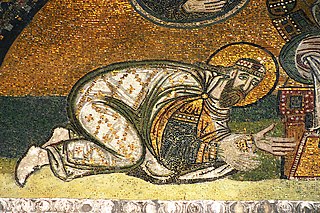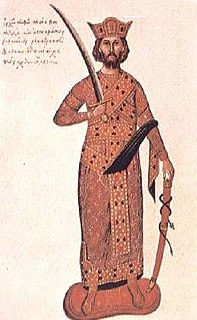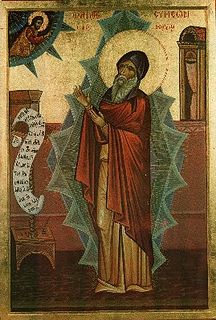 W
WArethas of Caesarea was Archbishop of Caesarea Mazaca in Cappadocia early in the 10th century, and is considered one of the most scholarly theologians of the Greek Orthodox Church. The codices produced by him, containing his commentaries are credited with preserving many ancient texts, including those of Plato and Marcus Aurelius' "Meditations".
 W
WAthanasius the Athonite, also called Athanasios of Trebizond, was a Byzantine monk who founded the monastic community on Mount Athos, which has since evolved into the greatest centre of Eastern Orthodox monasticism.
 W
WConstantine VII Flavius Porphyrogenitus was the fourth Emperor of the Macedonian dynasty of the Byzantine Empire, reigning from 6 June 913 to 9 November 959. He was the son of Emperor Leo VI and his fourth wife, Zoe Karbonopsina, and the nephew of his predecessor Emperor Alexander.
 W
WHero of Byzantium is a name used to refer to the anonymous Byzantine author of two treatises, commonly known as Parangelmata Poliorcetica and Geodesia, composed in the mid-10th century and found in an 11th-century manuscript in the Vatican Library. The first is a poliorketikon, an illustrated manual of siegecraft; the second is a work in practical geometry and ballistics, which makes use of locations around Constantinople to illustrate its points. The manuscript consists of 58 folios and 38 colored illustrations.
 W
WJohn Kaminiates was a Greek resident of Thessalonica when the city, then one of the largest in the Byzantine Empire, was besieged and sacked by a Saracen force led by Leo of Tripoli in 904. His account of the city's plunder, On the capture of Thessalonica, survives in four manuscripts; though of these, none were written before the fourteenth century, causing some concern over the text's authenticity.
 W
WLeo VI, called the Wise or the Philosopher, was Byzantine Emperor from 886 to 912. The second ruler of the Macedonian dynasty, he was very well-read, leading to his epithet. During his reign, the renaissance of letters, begun by his predecessor Basil I, continued; but the Empire also saw several military defeats in the Balkans against Bulgaria and against the Arabs in Sicily and the Aegean. His reign also witnessed the formal discontinuation of several ancient Roman institutions, such as the Roman consul and Senate, which continued to exist in name only and lost much of their original functions and powers.
 W
WNicholas I Mystikos or Nicholas I Mysticus was the Ecumenical Patriarch of Constantinople from March 901 to February 907 and from May 912 to his death in 925. His feast day in the Eastern Orthodox Church is 16 May.
 W
WNikephoros II Phokas, Latinized Nicephorus II Phocas, was Byzantine Emperor from 963 to 969. His brilliant military exploits contributed to the resurgence of the Byzantine Empire during the 10th century. His reign, however, included controversy. In the west, he inflamed conflict with the Bulgarians and saw Sicily completely turn over to the Muslims, while he failed to make any serious gains in Italy following the incursions of Otto I. Meanwhile, in the east, he completed the conquest of Cilicia and even retook the island of Cyprus, thus opening the path for subsequent Byzantine incursions reaching as far as Upper Mesopotamia and the Levant. His administrative policy was less successful, as in order to finance these wars he increased taxes both on the people and on the church, while maintaining unpopular theological positions and alienating many of his most powerful allies. These included his nephew John Tzimiskes, who would take the throne after killing Nikephoros in his sleep.
 W
WSymeon the Metaphrast was the author of the 10-volume medieval Greek menologion, or collection of saints' lives. He lived in the second half of the 10th century. About his life we know only very few details.
 W
WSymeon the New Theologian was a Byzantine Christian monk and poet who was the last of three saints canonized by the Eastern Orthodox church and given the title of "Theologian". "Theologian" was not applied to Symeon in the modern academic sense of theological study; the title was designed only to recognize someone who spoke from personal experience of the vision of God. One of his principal teachings was that humans could and should experience theoria.